
Capability Building for Change Readiness
No transformation succeeds without people who are ready, skilled, and supported. Capability building is how you get there.
Organizations undergoing transformation often focus on structures, systems, and strategy. But without capable people, change falls flat. This is why capability building—both in HR and across the workforce—is a central pillar of successful transformation.
1. What Is Change Readiness?
Change readiness is not just willingness. It’s a combination of:
- Skills: Do people know how to operate in the new way?
- Mindset: Are they open to letting go of the old and embracing the new?
- Confidence: Do they believe they can succeed in the new environment?
HR must treat these as capabilities to be developed, not traits to be assumed.
2. Identify Critical Capabilities
Not every skill needs to change—focus on the few that matter most:
- Digital fluency in a tech-driven transformation
- Agile behaviors in a restructured organization
- Inclusion capabilities in a DEI-centered change
Use strategic workforce planning to map future needs and current gaps.
3. Build HR’s Own Capabilities
Before HR can lead transformation, it must be transformation-ready itself. Key capabilities include:
- Data literacy for insight-driven decisions
- Design thinking for employee-centric solutions
- Facilitation & coaching to support leaders through change
- Business acumen to align initiatives with outcomes
4. Use Multiple Learning Methods
Capability building isn’t just training. Effective programs combine:
- Formal learning (courses, certifications)
- Learning in the flow of work (embedded resources, job aids)
- Peer learning (communities of practice)
- Action learning (real projects with coaching)
This blend ensures behavior change, not just knowledge acquisition.
5. Build a Culture of Learning and Growth
Capabilities thrive in an environment where:
- Learning is valued and visible
- Feedback is encouraged
- Growth is rewarded
Embed psychological safety, so people feel safe experimenting and learning in uncertain times.
6. Measure Progress and Iterate
Track capability building like any strategic investment:
- Pre/post assessments of confidence and competence
- Behavior observation and feedback
- Business impact metrics (e.g. adoption rates, speed to proficiency)
Refine programs based on real-world effectiveness.
Final Thought
Change readiness is not a mindset people “should” have—it’s a capability HR must build deliberately. When people are equipped and empowered, transformation becomes not only possible, but sustainable.